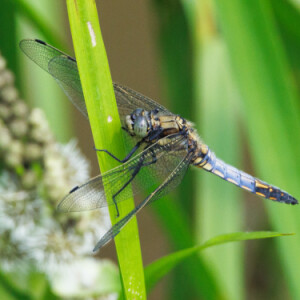Talk to the claw
R and I went for a walk at Croome this morning, where it was extremely hot and steamy. We strolled down to the lake and made one circuit around it, then R walked over to the house and back up to the café at a sensible pace, leaving me to hunt dragons on my own.
For a long time the Black-tailed Skimmer in the extras was my best capture, and destined to be my blip tonight. It's a male in a transitional state between juvenile and mature colouring, and like the semi-mature Scarce Chaser I posted last weekend, I found him more interesting and attractive than a fully mature specimen would have been. If you check out the BDS page for this species you'll see how far he's moved from the yellow and black of an immature male (which is very similar to the colouring of a female) towards the drab blue, black and brown of an adult.
Before and after photographing the Skimmer I'd been trying to get flight shots of a couple of Hairy Dragonflies, which were patrolling the channel on the south side of the large island. This is generally something of a fool's errand with hawker dragonflies: apart from Migrant Hawkers, which will hover in flight for a second or two if you're lucky, they tend to be fast, restless, unpredictable, and seemingly indefatigable, so photographing them in flight demands time and patience, and a lot of battery and memory card. Luckily I was looking for recording evidence today, rather than entry into the Wildlife Photographer of the Year, so a couple of blurry but identifiable images were good enough, and having got those I was preparing to move on towards the river - when this happened.
The legend around Hairy Dragonflies is that they don't perch. And if they do perch, they make sure to do it low down in reeds, where they're hidden. And if they perch somewhere visible they only do it later in the day, when they're tired - in the morning, you've got no chance of catching one at rest. For many insects I have enough personal stalking experience to have built up my own bank of behavioural observations and fieldcraft, but that's not the case with this species, so (despite all the many photos I've seen of perched Hairies) I've tended to simply accept the legend. Thus it was that when I saw this one drop into the reed bed and not come up again, I didn't immediately jump to the obvious conclusion. It was only when I took a step to my left and saw a flash of pale chequerboard pattern through the intervening foliage that I began to hope he'd actually landed, and at that point I started a slow and careful process of step...shoot...step...shoot that eventually got me to this photo.
To be fair to other readers of the Hairy Dragonfly runes, he was in a pretty inaccessible position: there was literally nowhere I could stand that gave me a clear view of all of him. But what you might call poor framing, I'm going to describe as environmental context. Basically, I'm happy - how could I not be? It's only the third time I've ever captured a perched male Hairy Dragonfly, and one of the other two was in cop with a female at the time, so presumably distracted. This chap was not distracted, and realised some while before I took this that he was being crept up on, but interestingly his initial response was to edge defensively round towards the back of the reed. I took another few frames after this one before it seemed to occur to him, suddenly and belatedly, that there was another potential solution to the problem - and at that point he took off, and disappeared like a tiny chequered rocket.


Comments
Sign in or get an account to comment.


